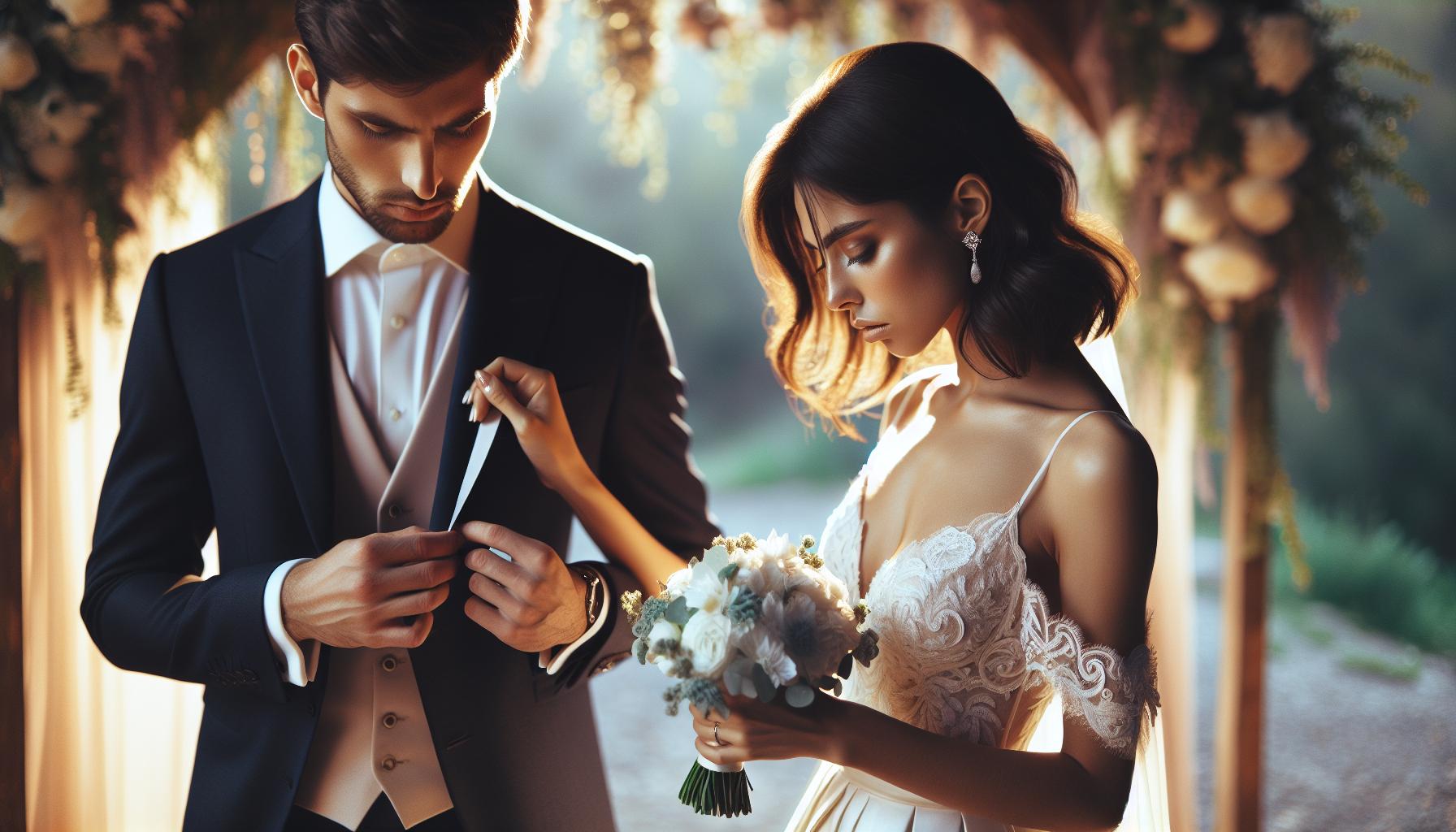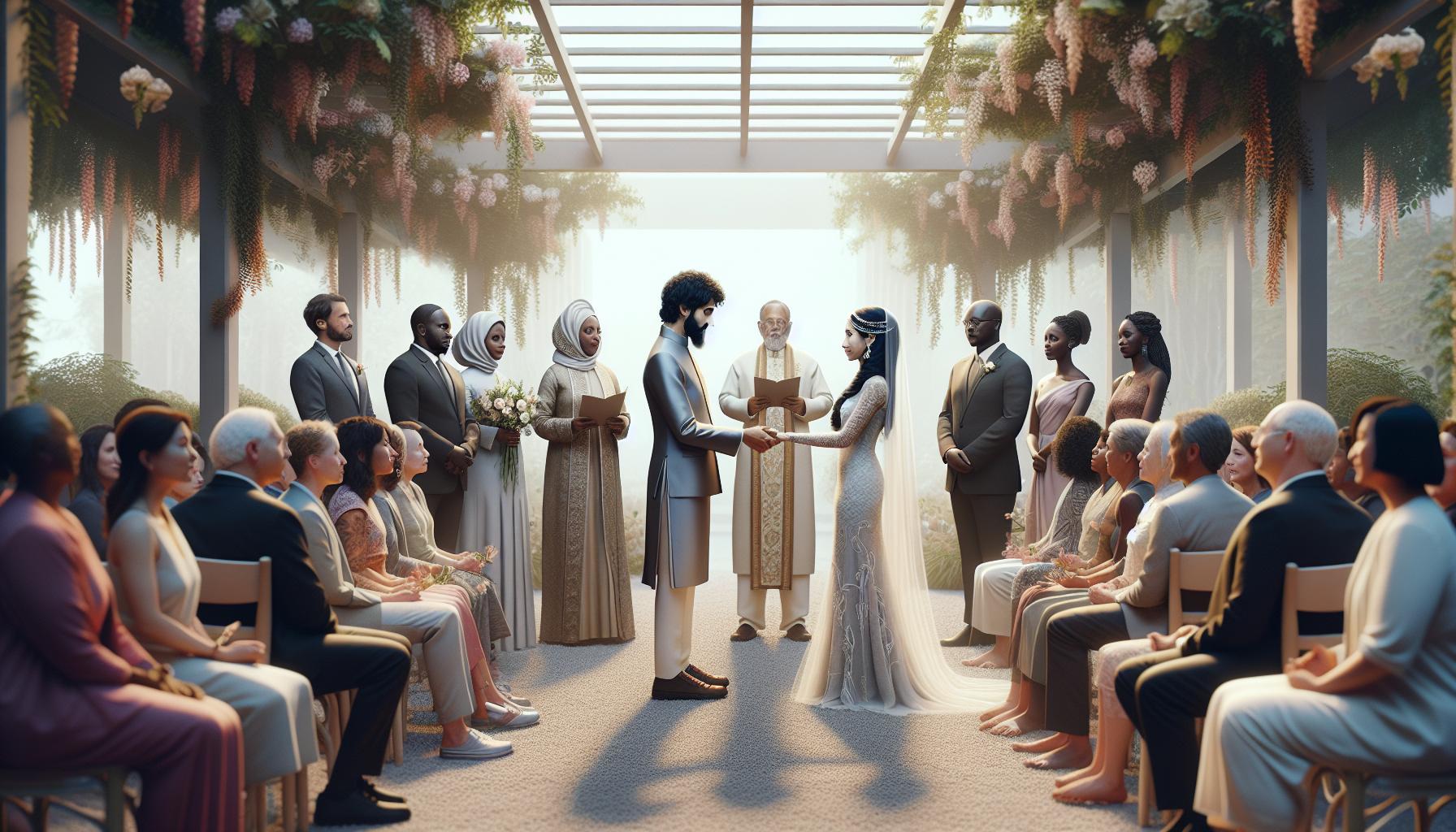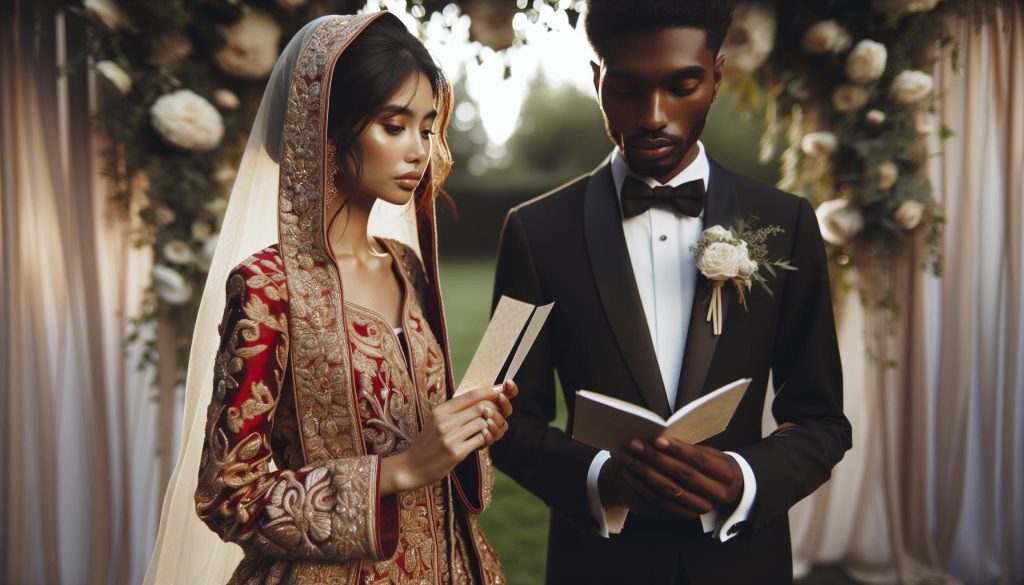The question of whether the bride or groom says vows first is a pivotal moment in many wedding ceremonies, symbolizing the couple’s commitment to each other. Understanding this tradition can enhance your wedding experience, allowing you to personalize your ceremony in a way that resonates with both your hearts and minds. With various customs across cultures, you may wonder which approach fits your style best. Are you leaning toward using traditional etiquette, or do you envision a more modern twist? By exploring the significance behind this aspect of your vows, you can ensure that your ceremony reflects your unique love story. Continue reading to discover the implications, variations, and advantages of each option, ensuring your special day flows seamlessly and meaningfully.
Understanding Vows: Bride vs. Groom Perspectives
When it comes to wedding vows, the perspectives of the bride and groom can vary significantly, reflecting their individual personalities, emotions, and expectations. This is not just a matter of personal sentiment; historical traditions often influence who speaks first, but the feelings behind those vows are deeply personal. Understanding these different perspectives can enrich the ceremony, making it even more meaningful.
Traditionally, the groom might say his vows first, a custom rooted in historical gender roles where men often took the lead in various public ceremonies. For many grooms, this moment can represent a promise of protection and provision, emphasizing their commitment to the well-being of their partner. On the other hand, brides often approach their vows as a deep emotional expression, focusing on love, partnership, and mutual support. This contrast can lead to a beautiful interplay of feelings during the ceremony, showcasing both the strength and vulnerability each partner brings to the relationship.
As couples create their own unique vows, they might find inspiration in each other’s perspective. For instance, a bride might take note of her groom’s straightforward promises of support and protection and intertwine them with her heartfelt expressions of love and understanding. Conversely, a groom might enrich his vows with more emotional depth, drawing from his bride’s eloquent sentiments. The dialogue between these perspectives not only emphasizes individual commitments but also celebrates the partnership that the couple is forming.
Ultimately, couples should feel free to choose the order of their vows based on their comfort and what resonates with their relationship. Whether a bride leads with her vows or a groom takes the first step, what matters most is the authenticity and sincerity of the promises made. In this intimate moment, each partner should feel empowered to share their hearts, rooted in love and understanding, paving the way for a joyous new chapter together.
Traditional Ceremony Order: A Historical Overview
Ceremony order, particularly regarding who says their vows first, has deep historical roots that reflect cultural norms, societal expectations, and evolving gender roles. Traditionally, the groom has often set the stage by saying his vows first. This custom is not merely a matter of sequence; it symbolizes the established norms of masculinity and the protective role that men have historically played within marriage. For countless generations, marriages were arranged or viewed through the lens of socio-economic partnerships, with the groom typically taking the lead to assure his commitment to provide and protect.
In many cultures, this sequence also stems from the religious and ceremonial practices where the groom’s vows often contained pledges of duty and service. By expressing these promises first, the groom would establish a foundation of loyalty and strength, setting a tone for the commitment to be reciprocated by the bride. This dynamic has fostered a beautiful balance in the exchange, emphasizing that while the groom’s role is initiating those promises of devotion, the bride’s vows bring in the emotional, nurturing aspects of the relationship.
As times have changed, so too have interpretations of these traditions. Modern couples frequently challenge the conventional order, leading ceremonies in ways that feel most authentic to them. It’s increasingly common for brides to lead with their vows, showcasing their strong emotional connection and commitment to partnership. This shift reflects a growing emphasis on equality and mutual influence within marriages, celebrating the individuality of each partner.
Ultimately, the decision on who speaks first should resonate with the couple’s values and relationship dynamics. Regardless of the order, the heartfelt expression of vows creates a shared commitment that resonates deeply within the ceremony, solidifying the couple’s bond as they embark on their journey together. As you plan your wedding, consider what feels right for both of you-whether rooted in tradition or modern interpretations, your vow exchange will be a memorable highlight of your celebration.
Modern Variations: Changing the Vow Sequence
Shifting societal norms and evolving personal values have transformed the way modern couples approach their wedding vows. Today, many couples choose to break free from traditional sequences, allowing each partner to express their love and commitment in a manner that feels true to their unique relationship. This evolution creates a dynamic and personalized experience that reflects the couple’s individuality while embracing a broader understanding of partnership within marriage.
Couples are now exploring various vow exchange orders, selecting what resonates most with their emotional connection. It has become increasingly popular for brides to speak their vows first, symbolizing a departure from historical roles and highlighting the strength of their voice in the relationship. This shift not only emphasizes equality but also places significant emotional weight on the bride’s promises, allowing her to set the tone for a loving and reciprocal exchange. In other instances, couples might choose to alternate their vows, creating a beautiful interplay of promises that showcases their teamwork and shared journey.
When considering variations in vow sequence, it’s crucial to communicate openly with your partner about your preferences. Brainstorm together about how you envision the moment-do you want it to be solemn, lighthearted, or a mix of both? You might also incorporate elements of surprise, such as personal anecdotes or inside jokes, into your vows to make the experience even more memorable. Including family traditions or cultural customs into the vow exchange can also add a rich layer of meaning, merging personal significance with the broader celebration of love.
Ultimately, the goal is to create a ceremony that resonates with both partners, crafting an atmosphere that celebrates your unique bond. Whether you choose a traditional approach or a modern twist, remember that the focus should be on the heartfelt commitment being made. Personalizing your vow exchange can transform this pivotal moment into an unforgettable highlight of your wedding day, leaving a lasting impression on both you and your guests. Embrace the opportunity to express your love in a way that is entirely yours-after all, this is the start of a lifelong journey together.
Cultural Differences in Vow Presentation
Weddings are as diverse as the cultures that celebrate them, and this rich tapestry of traditions profoundly influences how vows are presented and exchanged. In various cultures, the order of speaking vows not only reflects personal beliefs but also upholds family values and historical practices. Understanding these differences can help couples personalize their ceremony in a way that honors their backgrounds while celebrating their unique love story.
In many Western cultures, it is common for the groom to speak his vows first, traditionally framing the ceremony with his promises before the bride counters with hers. This approach often signifies a more paternalistic view of relationships; however, modern couples are increasingly challenging this norm. For instance, in some African cultures, the bride may present her vows first, showcasing her commitment and strength within the relationship. This shift toward gender equality not only empowers brides but also reflects broader societal changes regarding partnership dynamics.
Similarly, in Hindu weddings, the couple participates in the Saptapadi, or seven steps, during which they make vows to each other as they take seven steps together, symbolizing mutual respect and companionship. Each promise made during this ritual deepens the bond between the couple and emphasizes the importance of collective commitment. This communal aspect of vow exchange further highlights how cultural settings shape the meaning and priorities behind the wedding vows.
When considering how to incorporate cultural practices into your vow exchange, think about the following aspects:
- Family Traditions: Discuss with family members to understand what traditions hold significance. These conversations can spark ideas that resonate with both partners.
- Location: Contextualizing vows within the cultural framework of your venue can enhance the ceremony’s impact, making it more meaningful for you and your guests.
- Symbolism: Incorporate symbols or items from your culture that carry significance, allowing these elements to add depth to your vows.
Embracing can transform your wedding into a beautiful blending of histories and promises, making it a celebration that honors not just your love, but also the legacies that brought you together. The fusion of traditions fosters a rich experience for both partners and their families, creating cherished memories that will last longer than the wedding day itself.
What to Consider When Choosing Vow Order
Choosing who says their vows first can set the tone for your entire ceremony, as it reflects the dynamic of your relationship and the traditions you value. Many couples face the decision of whether the bride or groom should go first, often influenced by cultural norms and personal feelings. This choice is not just about tradition; it’s an opportunity to express your love and commitment in a way that feels right for both of you.
One approach is to honor traditional customs. In many Western ceremonies, it’s common for the groom to speak first, often viewed as a way to establish his commitments before the bride shares her promises. Conversely, some couples may choose to flip this convention, allowing the bride to go first to underscore her strength and independence, making a statement about equality in their partnership. If you lean towards progressive values, starting with the bride can symbolize a modern interpretation of vows and partnerships.
In addition to traditional structures, consider the overall flow of your ceremony. Whether you pick a traditional order or something more contemporary, think about how each partner’s vows can complement one another. For example, if one partner’s vows lean heavily on romantic notions, it might be impactful for that person to speak last, allowing the other to build up to those sentiments. This way, the vows create an emotional crescendo, leaving your guests with a powerful feeling as the ceremony concludes.
Lastly, reflect on the emotional resonance of your vows. If one partner may become particularly emotional or teary-eyed, consider who might be more composed in that moment. This practical aspect can help ensure that the vows are delivered with clarity, allowing both partners’ sentiments to shine through. Engage in open discussions about your preferences, and let them guide the decision-making process, ultimately culminating in a vow exchange that feels authentically you. Embrace this moment as a celebration of both your love and your unique journey together.
Steps to Personalize Your Vow Exchange
When planning to exchange vows, making the moment uniquely yours is paramount. Personalizing your vow exchange can transform a ceremonial routine into a profound testament of your love story. Here are steps to help inspire and guide you through this heartfelt customization.
Start by reflecting on your journey together. Consider key moments that have defined your relationship, such as how you met, memorable adventures, or the challenges you’ve overcome. Use these experiences as a foundation for your vows. Speak from the heart about what you appreciate in each other-qualities that make your bond special. This personal touch not only captivates your audience but reinforces the intimacy of your commitment.
H3: Make It Visual
To further enhance the significance of your vows, think about visual elements that resonate with both of you. You might choose to include items that symbolize your connection, such as matching tokens or keepsakes. For instance, incorporating family heirlooms can also honor your backgrounds and traditions. Discuss these ideas together-creating a unique experience fosters a deeper emotional connection.
H3: Incorporate Your Style
Whether your relationship is filled with humor, adventure, or deep romance, your vows should reflect your personalities. Feel free to get creative-use quotes from your favorite books, songs, or personal anecdotes that resonate with your shared beliefs. This approach not only adds depth to your vows but also showcases your individuality as a couple.
H3: Practice Makes Perfect
As the big day approaches, don’t overlook the importance of rehearsal. Practicing your vows together can alleviate some pre-ceremony jitters. Choose a comfortable atmosphere, perhaps during a quiet evening together, and read them aloud. This practice will help you become more familiar with your words and ensure they flow naturally. Furthermore, feedback from one another can refine your messages and help evoke the emotions you want to express on the day.
Ultimately, personalizing your vow exchange is not just about the words spoken-it’s about the shared moment that encapsulates your love and commitment. Embrace the process, create memories, and honor your unique journey together as you prepare to embark on this new chapter.
Common Mistakes: Vows and Ceremony Flow
Navigating the flow of your wedding ceremony, especially during the vow exchange, requires careful consideration to avoid common pitfalls that can disrupt this significant moment. Many couples underestimate how crucial the sequencing of vows can be, often leading to an unbalanced emotional tone or miscommunication. Understanding that the energy of the ceremony flows through these exchanges is vital, and missteps can detract from the sincerity of the moment.
One common mistake is not coordinating the vow delivery with the emotional tenor of the ceremony. For instance, if one partner is particularly emotional, and the other remains unengaged, it could alter how relatable or heartfelt their delivery seems. To mitigate this, consider practicing together and discussing the emotional beats you’d like to hit. Sharing your vows aloud can help create a rhythm and enhance connection, ensuring both of you resonate on the same emotional wavelength during the ceremony.
Another frequent oversight is neglecting to reflect on the audience’s perspective. While the focus should undoubtedly be on the couple, it’s essential to consider how vows will be perceived by family and friends. For instance, inside jokes or overly personal anecdotes might alienate the audience instead of engaging them. Strive for a balance between intimacy and inclusiveness in your vows, which can be achieved by incorporating universal themes of love, commitment, and respect.
Additionally, not being mindful of the practical aspects of vow exchanges, such as timing and location, can disrupt the flow of your ceremony. If one partner’s vows are significantly longer than the other’s or if they stray too far off-script, it could lead to an awkward pause or a rushed conclusion. Aim for a balance in length and content, and be sure to rehearse the timing. This attention to detail will create a more fluid ceremony, allowing the love and emotion of the moment to shine through without interruptions.
Ultimately, the vow exchange is a beautiful highlight of the wedding ceremony, deserving of careful planning and thoughtful execution. By avoiding these common mistakes, you can ensure that your vow exchange is a deeply moving experience both for you as a couple and for your guests witnessing this cherished moment.
Incorporating Family Traditions into Your Vow Exchange
Including family traditions in your vow exchange can create a deeper, more meaningful experience for both the couple and their loved ones. Often, wedding ceremonies serve not only as a union of two individuals but also as a celebration of the families that raised them. Whether you have specific customs or general family values you cherish, weaving these elements into your vows is a wonderful way to honor your heritage and make your ceremony uniquely yours.
One approach is to consider traditions from both the bride’s and groom’s families, recognizing the beauty in diversity. This can manifest in various ways, such as incorporating specific phrases or blessings that have been passed down through generations. For example, if a family member traditionally recites a particular poem or quote during ceremonies, adding it before or after your vows can honor that lineage while emphasizing your commitment. Additionally, using familial anecdotes in your vows can draw poignant parallels between your relationship and your parents’ or grandparents’ love stories, illustrating the qualities you admire and aspire to emulate.
Another effective way to blend family traditions into the vow exchange is to involve relatives in the process. Consider asking a parent, grandparent, or sibling to contribute a blessing or add their voice to a specific part of the ceremony. This inclusion not only respects familial ties but also fosters a sense of unity and shared joy. Engaging family members can take on various forms, like writing a joint vow or incorporating a family emblem into the ceremony’s decor to symbolize the joining of two families.
Ultimately, the goal is to create a ceremony that reflects who you are as a couple while celebrating the roots from which you both come. Remember, this is your moment-take the opportunity to create a tapestry of love, respect, and tradition that honors your past while looking forward to a bright future together. Planning how to incorporate family traditions into your vows can enhance the emotional richness of this pivotal moment, transforming it into a heartfelt expression of love that resonates with everyone present.
Creating a Meaningful Experience: Tips for Both Partners
Creating a meaningful and memorable experience during your vow exchange is crucial for both partners as it seizes a moment that is deeply personal yet celebrated by loved ones. One effective way to enhance the sentiment of this occasion is by fostering open communication between partners. Discuss your thoughts and feelings about what marriage means to you, what you hope to express, and any emotions you want to convey. This collaborative approach can enrich your vows, ensuring they reflect both your individual commitments and your shared vision for the future.
Utilizing Practiced Phrases and Personal Stories
Incorporating practiced phrases or time-honored quotes can lend a sense of gravity to your vows. You might want to draw inspiration from meaningful literature, religious texts, or even songs that resonate with your relationship. Sharing personal anecdotes can also amplify the emotional weight. For instance, recounting a pivotal moment in your relationship or an experience that solidified your love can help anchor your vows in authenticity. Consider using storytelling techniques: a dialogue of moments, evoking humor, or even expressing your dreams as a couple can make the exchange feel vibrant and alive.
Setting the Scene with Intention
The environment of your ceremony can profoundly influence the experience. Choose a location that resonates with both of you, whether it be a grand venue that captures the essence of your love story or a simple, intimate setting that feels like home. Engage the senses by considering elements such as lighting, music, and décor; they should complement the emotional setting of your vows. You might even set aside a moment before the exchange to breathe and center yourselves, allowing the significance of what you’re about to undertake to settle in fully.
Involving Family and Friends
Another way to enrich your experience is by thoughtfully involving family and friends. Depending on the traditions you want to honor, you could invite them to share blessings or readings that have personal significance, thereby creating a tapestry of love that extends beyond just the two of you. Involving loved ones can also relieve some of the pressure on you both during the vow exchange, transforming it into a shared celebration rather than an isolated event.
By weaving these threads together-open communication, practiced phrases, intentional surroundings, and family involvement-both partners can create an extraordinary moment that not only honors their love but also resonates with everyone present. This thoughtful planning transforms a simple exchange into a profound declaration that celebrates the journey ahead, filled with love, laughter, and shared dreams.
Balancing Traditions with Personal Touches
In the intricate dance of love and commitment, the exchange of vows stands as one of the most pivotal moments of a wedding ceremony. While many couples adhere to traditional sequences-often with the bride or groom following customary norms-balancing these customs with personal touches can transform the experience into something uniquely special. Embracing both tradition and individuality allows couples to create a ceremony that reflects their heritage while also celebrating their shared journey.
At the heart of marrying tradition with personal flair lies the decision of who speaks first. In some cultures, it’s customary for the bride to recite her vows first as a symbol of her beginning a new chapter in life, while in others, the groom leads the way to signify his commitment. Couples should reflect on what feels most authentic to them and consider including personal elements. For instance, if you’re leaning toward a traditional sequence, you might weave in personal anecdotes or favorite quotes that resonate with your relationship’s core values. This can introduce heartfelt, memorable moments that elevate the vow exchange beyond mere formality.
Creating Harmony Between Traditions and Personalization
Blending traditions with personal touches can be a beautiful way to honor family values while recognizing the couple’s identity. Consider the following suggestions:
- Honor Family Backgrounds: Share components from each family’s traditions, such as specific rituals or blessings, to create a blended ethos that respects both sides.
- Customize Vows: Write vows that incorporate elements of traditional vows but infuse them with your unique stories and aspirations. You might start with “I promise to cherish you,” then add a personal anecdote that illustrates how that promise has already been honored.
- Include Symbolic Gestures: Whether it’s lighting a unity candle, participating in a sand ceremony, or even a dance that reflects your cultural backgrounds, symbolic gestures can serve as a bridge between tradition and personal meaning.
In the end, the exchange of vows should resonate deeply with both partners and their loved ones, creating an atmosphere that is charged with love and authenticity. The integration of personal touches into traditional vows not only honors your respective heritages but also offers an opportunity to articulate your commitment in a way that feels true to your journey together. By thoughtfully crafting this moment, you’re shaping a celebration that reflects both the beauty of tradition and the uniqueness of your love story-an enduring memory for years to come.
Planning the Perfect Ceremony Timeline
A well-crafted ceremony timeline serves as the backbone of a successful wedding, ensuring that every moment flows seamlessly into the next. From the moment guests gather to the final send-off, careful planning of the schedule allows couples to navigate their emotional day with ease. Deciding the order of who says their vows first is a key part of this timeline, steeped in tradition and personal significance. With this in mind, it’s essential for couples to take their preferences and any cultural customs into account when creating their schedule.
When planning your ceremony timeline, consider the following factors to ensure everything runs smoothly:
- Ceremony Length: A traditional vow exchange may take a few minutes, but if you’re personalizing your vows or including a special reading, factor in additional time for these heartfelt moments. Generally, aim for a 20 to 30-minute ceremony to keep guests engaged.
- Order of Events: Outline each critical moment, starting with the processional, then moving to the welcome, vow exchange, and ring ceremony. Make sure to clarify who is saying their vows first, whether it is the bride or the groom-this decision might not only affect the emotional tone, but also how guests perceive the structure of the ceremony.
- Rehearsal Timing: Schedule a rehearsal for at least a day or two before the wedding, so everyone feels comfortable with the timing. This is especially crucial if you’re blending different cultural traditions that may influence the order of events.
- Include Buffer Times: To avoid any unnecessary stress, build in some buffer periods between segments for unexpected delays. For example, if the groom is to say his vows first, a few extra moments can help him compose himself and ensure the emotional weight of the moment is felt fully.
Creating a detailed timeline not only helps in managing your wedding day more effectively but also allows for those spontaneous, magical moments to happen. Whether you lean toward a traditional ceremony where one partner’s vows take precedence or choose to alternate personal expressions for a more contemporary approach, being organized can ease any pre-wedding jitters and foster a joyful atmosphere where love can flourish freely. Celebrate this beautiful occasion by dedicating the necessary time and thought to your ceremony’s flow, allowing you and your partner to truly savor each moment as you embark on this unforgettable journey together.
Unique Ideas for Vow Exchange Moments
The moment of exchanging vows is often described as the heart of the wedding ceremony, where emotions run high and promises are fulfilled. To make this moment unforgettable, consider incorporating unique ideas that reflect your personalities and shared journey as a couple.
One creative approach is to write your vows together before the ceremony. This not only allows you to calibrate your tones and intentions, but it also fosters deeper communication about what you both envision for your future. Imagine stepping up to the altar, sharing vows that are beautifully intertwined and representative of your partnership, creating a harmonious rhythm that guests can feel.
Another exciting option is to incorporate a symbolic gesture during the vow exchange. For instance, you could plant a tree or exchange small tokens like love letters, to be opened on your first anniversary. This adds a tangible element to your promises, transforming words into lasting memories. Similarly, consider a vow exchange in a beautiful outdoor setting, allowing the natural backdrop to enhance the grandeur of the moment, or include meaningful music that plays softly while you speak your vows, enriching the atmosphere.
Think about incorporating traditions from both families that resonate with you. For example, lighting a unity candle, tying a knot, or performing a ritual that honors your heritage can add a personal touch to the ceremony. These actions not only deepen the meaning of the vows but also celebrate the joining of both families, making the event more inclusive and heartfelt.
In short, while the order of vows traditionally leans towards the bride or groom, adding these unique experiences can transform the ordinary into the extraordinary. By blending personal flair with meaningful traditions, you can set the stage for a deeply memorable exchange that resonates with both your guests and your future together.
Faq
Q: Who traditionally says their vows first at a wedding ceremony?
A: Traditionally, the groom says his vows first, followed by the bride. This order has historical roots in many cultures, reflecting the perception of the groom as the leader in the ceremony. Couples can choose to personalize this order based on their preferences or cultural customs.
Q: Why do some couples choose to switch the vow order?
A: Some couples opt to reverse the traditional vow order to symbolize equality and a unified commitment. This choice offers a modern twist to the ceremony and can make the exchange feel more personal and meaningful.
Q: What does the vow exchange symbolize in a wedding?
A: The vow exchange symbolizes the commitment and promises that each partner makes to one another. It’s a heartfelt moment that emphasizes love and loyalty, laying the foundation for the couple’s future together.
Q: Are there cultural differences in vow order during weddings?
A: Yes, cultural variations exist in vow order. In some cultures or religions, the bride may say her vows first or both partners may exchange vows simultaneously. Understanding these traditions can add depth to the ceremony.
Q: How can couples personalize their vow exchange?
A: Couples can personalize their vow exchange by writing their own vows, incorporating specific promises, or choosing a unique setting or moment within the ceremony. This personalization enhances emotional connection and makes the experience truly unforgettable.
Q: What to consider when deciding who says vows first?
A: Couples should consider personal comfort, family traditions, and cultural customs. Discussing preferences together can help ensure that the ceremony reflects both partners’ values and desires, creating a memorable experience.
Q: Can vow exchanges be conducted in a different format or style?
A: Yes, vow exchanges can vary in format; couples may choose to exchange vows in a private moment, through a symbolic act, or during a group ceremony. Flexibility in style can cater to personal preferences and enhance the meaning of the vows.
Q: What are common mistakes to avoid during the vow exchange?
A: Common mistakes include forgetting important elements, rushing through the exchange, or neglecting to practice beforehand. Ensuring you’ve prepared adequately can prevent mishaps and make the exchange smooth and heartfelt.
For deeper insights into how to navigate the ceremony and make your vows memorable, check out sections on “Steps to Personalize Your Vow Exchange” and “Creating a Meaningful Experience: Tips for Both Partners” in our main article.
In Conclusion
As you embark on your wedding planning journey, understanding the traditions around who says their vows first can help set the tone for your ceremony. Whether you choose to follow tradition or create your own path, the most important aspect is to make your vows personal and heartfelt. Don’t let uncertainty hold you back; explore our thoughtfully curated collection of wedding vow examples to inspire your unique promises to one another.
While you’re here, check out our guide on wedding ceremony etiquette and tips for writing meaningful vows to ensure every detail is just right. Remember, your love story deserves to be celebrated in a way that reflects your personalities and commitment. Dive deeper into other valuable resources tailored to enhance your wedding planning experience. Embrace the excitement of this special time, and let every decision lead you closer to the unforgettable day you envision!











